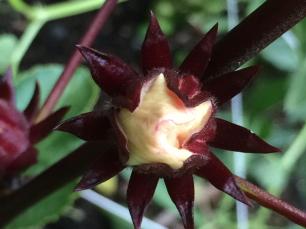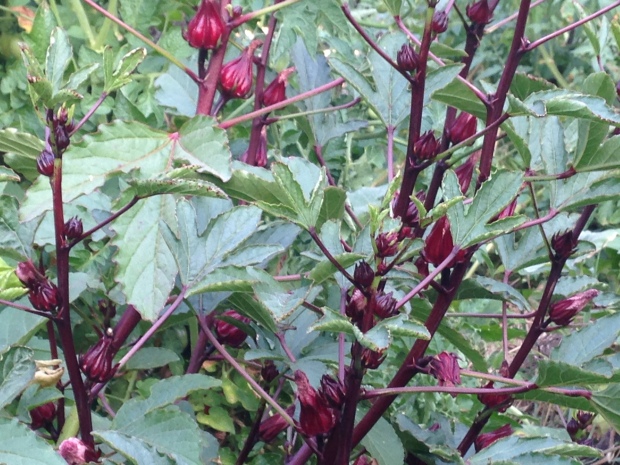Hibiscus Sabdariffa: Roselle, Jamaican Sorrel, Flor de Jamaica, Bissap
Basics: Plant after danger of frost has passed. Takes off in mid summer, when soil is consistently warm. 45 days. Will bloom until late summer/early fall- very striking when mature. Continuous harvest of fresh, tender leaves; harvest calyxes before flowers bloom for best flavor. Pinch back for more branching.

- Roselle calyxes with flower bud. The thick red calyxes are the part used for recipes; the delicate cream colored flower lasts just a day. (Photo copyright Mary Unruh, used with permission.)
ROSELLE is native to West Africa and was brought to Jamaica by enslaved Africans in the 1600’s. Now it is grown and consumed all over the world. Its leaves and calyxes can be eaten fresh, for a sweet and tart treat, and the calyxes are the dried hibiscus most commonly known in North America as Red Zinger tea. In the Caribbean, since the flowers there mature in early winter, hibiscus is typically made in a Christmas beverage, simmered together with fresh ginger and sugar, then mixed with rum. See below for great Roselle recipes and other popular Haitian beverages.
Here in Oregon, we treat the plants as we would tomatoes, starting them early indoors in greenhouse conditions, and then transplanting when all danger of frost had passed. Planted in full sun, they took off in mid-summer and were still flowering in October, when the cold rain stopped the action. Roselle was another favorite of our volunteer gardeners in the trials, and anyone who grew one plant plans to grow several next season! These plants are also drought tolerant, though they need regular watering as they get established. Visit our roselle photo album to see the plants growing in the trial garden. Ira Wallace of Southern Exposure Seed Exchange has written a great Hibiscus sabdariffa growing guide in a Mother Earth News article.
Hibiscus is the national flower of Haiti, and there are numerous hibiscus relatives brought to the Caribbean and the American South from Africa– okra, jute (bush mallow), and the roselle.
Hibiscus tea is the easiest way to use your roselle plant– simmer the stems, leaves, calyxes and all, for a couple of hours, cool, strain, and chill for a highly nutritious drink. The smaller, tender leaves are edible raw– they taste similar to sorrel or oxalis leaves. Any of the leaves can be cooked down like any other green.
Dry the calyxes before the blooms form to preserve them for future hibiscus tea.
In the Caribbean, roselle is often boiled with fresh ginger and sugar. Drink it hot or cold, and mix with rum if you like.
The buds and calyxes contain pectin, which is useful in making jams and jellies. They are really delicious mixed into ice cream.
Roselle is VERY high in anthocyanins and vitamin C, and in folk medicine has been used as a diuretic. It’s a great cooling summer beverage. The Wikipedia entry on Roselle is full of useful information and links.
Other popular Haitian beverages:
Akasan (or Aksan, or Aka-100), a signature cornmeal drink– the author of this recipe points out that corn-based drinks are popular throughout the Americas because of the influence of indigenous peoples and maize crops– in Haiti, the drink developed out of a Taino version, and involves spices that traveled the world in the age of European exploration and colonization, sometimes referred to, in terms of horticulture, as the Columbian Exchange.
Kremas are another national favorite, coveted for celebrations. Haitians use condensed milk in general because of lack of refrigeration, and the expense of fresh milk.
Fresh, potable water is not as easy to come by in Haiti as in North America– fresh juices are frequently consumed, providing hydration and nutrition from the abundant tropical fruits that can grow on the Caribbean island. Haiti is famous for its rum, Prestige beer, and other popular beverages favored throughout the Caribbean, including Malta, different carbonated commercial drinks (like Mauby!), and the various drinks made from the beautiful roselle plant featured above.
